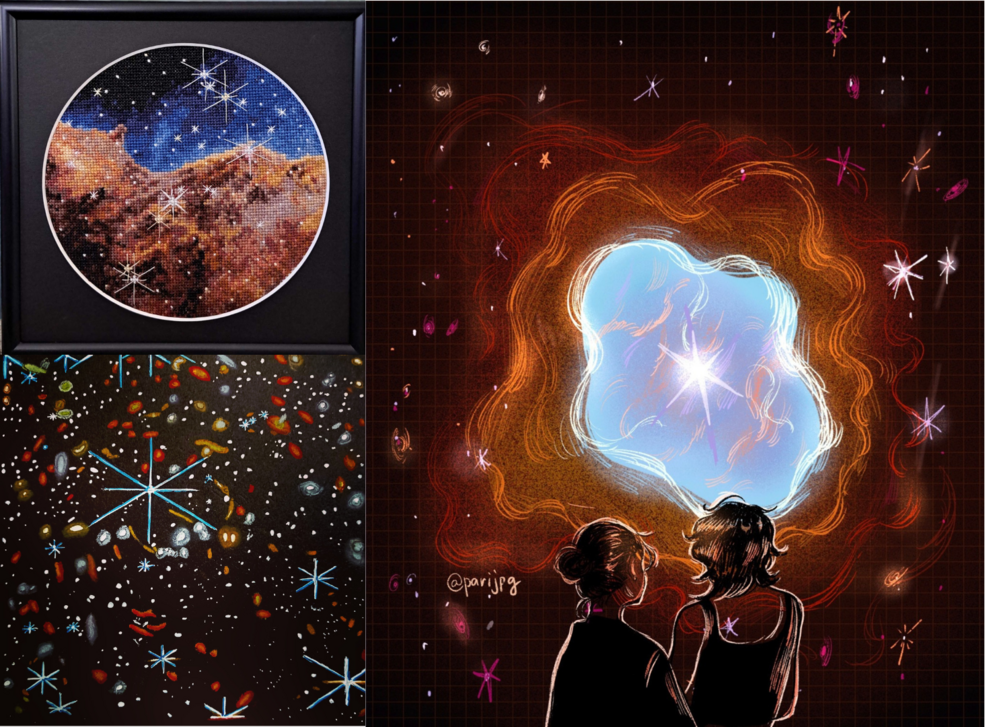Ananya Udaygiri
NASA’s Goddard Space Flight Center, Greenbelt, MD.
“Certain art cannot be described, it must be seen and experienced,” reads a sign in front of “Beyond the Light,” a new immersive visual experience inspired by NASA images. Over the 25-minute duration of NASA’s collaboration with digital art space ARTECHOUSE, viewers watch projections of interstellar light, dust, and stars wash over the alabaster walls of the hall.
ARTECHOUSE’s NASA-inspired exhibit opened Friday, Sept. 15, in Washington, featuring visuals from NASA’s James Webb Space Telescope and Hubble Space Telescope, as well as software-generated audio that corresponds to the light seen in each image. In a hall of 13 million pixels and 18K resolution film, participants do more than see the universe – they watch it fly past them.
“That’s the way it should be,” said ARTECHOUSE founder Sandro Kereselidze. “It should be fun.”

Credits: NASA/Wade Sisler
“In a very deep way, I think that our perception of art and beauty may be as real an experience of the nature of the universe as measuring it with formal sciences,” said Michelle Thaller, the assistant director for science communication at NASA’s Goddard Space Flight Center in Greenbelt, Maryland. “There isn’t a way to be a scientist and a way to be an artist,” Thaller said. “There’s just many, many ways to be human.”
Thaller and other scientists from NASA Goddard provided input to ARTECHOUSE during the brainstorming process, inspiring the gallery to center their narrative around how humans interact with light, both from scientific and artistic domains.
“They had some phone calls with us where we talked about what Webb does and what it sees and why it’s important,” Thaller said. “And they also wanted to hear about some of the more intriguing things about physics, like space and time.”

Credits: NASA/Wade Sisler
“What’s so amazing about the James Webb Space Telescope is that the whole world came together to build it. The images that this remarkable machine delivers to all of us from space remind us of our connectedness to each other,” said Laura Betz, the communications lead for the Webb telescope at Goddard, who spearheaded the collaboration for NASA. “Art inspired by the mission, such as the ‘Unfold the Universe’ public campaign we run, helps show the public what captivates us in those images.”
After an ARTECHOUSE team visit to Goddard, several months of phone calls, a presentation of their proposal, and suggestions from Goddard scientists, ARTECHOUSE was ready to begin designing.
“Art allows people who don’t naturally gravitate to science to see it in a different light, and to be able to take in what they can from it,” Betz said. “That’s what makes it accessible.”
ARTECHOUSE is the latest example of Webb’s potential to inspire art, which has been a component of the mission’s outreach efforts as far back as 2016: NASA hosted a social media event where artists could apply for the chance to create in front of the then-unfinished Webb telescope as it was being built and tested on Goddard’s campus. The creatives were encouraged to design artwork inspired by the construction of the telescope and the scientific discoveries it would uncover. Months later, the artwork was revealed in an in-person exhibit at the NASA Goddard Visitor Center.

Credits: Courtesy of Wendy Edwards; Kirthi Jayakumar; Parijat Bhattacharya
More recently, in May NASA visuals – including those from Webb – combined with a live symphonic orchestra in “Cosmic Cycles,” a multimedia collaboration among Goddard the National Philharmonic, and composer Henry Dehlinger.
The ARTECHOUSE exhibit previously ran in New York City over the summer. In September, when ARTECHOUSE opens its doors to the community in Washington, it’ll come as yet another installment in a rich history that NASA shares with artists.
The James Webb Space Telescope is the world’s largest, most powerful, and most complex space science telescope ever built. Webb is solving mysteries in our solar system, looking beyond to distant worlds around other stars, and probing the mysterious structures and origins of our universe and our place in it. Webb is an international program led by NASA with its partners, ESA (European Space Agency) and the Canadian Space Agency.









